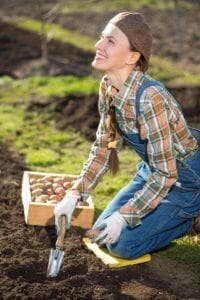Even though it may be a little chilly outside still, spring is still in the offing. The ground is thawing out, the temperatures are warming up, and the sun is lingering a bit longer each day. It’s is time to think of spring planting.
Spring planting includes the plants that you start both indoors and seeds that can go into the ground. Here are a few:
Warm Weather Herbs
Believe it or not, those herbs that revel in the heat can be started in February. They include:

- Oregano – Don’t worry overmuch about sowing the tiny oregano seeds. They do not even need to be covered up. The seeds germinate in about four days, and the plants are ready for harvest when they’re only about 6 inches tall. Cutting them early encourages a bushy growth.
- Basil – Basil can be started indoors about nine days before the gardener expects the last frost. Space the plants 10 to 12 inches apart in beds and 12 to 18 inches apart in rows. Basil loves to grow around peppers and tomatoes and is said to enhance their flavor. It’s also used to repel flies and mosquitoes.
- Dill – Sow dill seed in a protected spot just in case there’s a colder than expected night. It also does wonderfully in a large pot. The pot needs to be large and deep because dill has a long taproot. But once it is established, don’t transplant it.
The cool, wet weather of Spring is perfect to start your early garden plants
- Lettuce – Start lettuce indoors or in the ground. Though most kinds of lettuce seeds germinate in about four days, they have different maturity dates. Iceberg and other head lettuces mature between 60 to 95 days; leaf lettuce matures between 45 and 65 days, and romaine lettuce matures between 55 and 80 days. Plant them close together if baby lettuce is desired.
- Onions – There are many types of onions, and each seems to need different handling. But we recommend that our Southern Oregon customers choose short day onions. Onions that are started from seeds tend to be larger when they’re harvested, but sets are faster to grow. Plant about four weeks before the last frost date.
- Peppers – Whether mild or blazing hot, peppers love to be planted together and do fantastically well in pots. Plant the seeds about 8 to 10 weeks before the last frost date. Make sure the containers are roomy to encourage the plants to start producing early and to cushion transplant shock if they are placed in the ground.
- Tomatoes – There are so many tomatoes that it’s difficult to pick just one, so choose a bunch of varieties. Unlike some other warm season veggies, tomatoes can all be grown pretty much the same way. Sow seeds in flats at least 1/2 inch apart, and make sure they get at least 14 hours of light per day. When the seedlings have four leaves, its time to transfer them to a deeper pot. Then, transfer them to an even deeper container when they’re about 8 inches tall. Let them harden off for about ten days before putting out in the garden.
Seedlings of any variety can be very delicate and need a lot of light. For the best results, start them indoors. Either grow lights can be used or a fluorescent light with one warm bulb and one cool. If you hang the light from a chain, it can be moved up as the plants flourish and begin to grow. Seedlings should be kept damp, not wet.
It is best if seedlings are started with a sterile seed-starting mix that is light and fluffy to hold the right amount of moisture. You can use bagged seed-starting mix, or buy compressed pellets of peat or coir that expand when wet.
Stop by Hilton Landscape Supply and take a look at our landscape and garden products for your spring planting needs.
